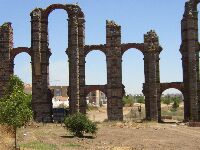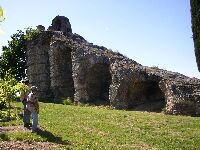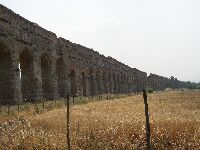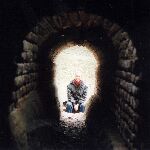| Distance |
|
| 1 roman foot (pes) |
0,296 m |
| 1 actus (=120 pes) |
35,5 m |
| 1 roman mile |
1480 m (5000 feet) |
| Distance between manholes (putei) |
|
| Vitruvius 8,4,3 |
1 actus (120 Rf) |
35,5 m |
| Plinius NH 31,31 |
2 actus (240 Rf) |
71 m |
| Burdy Gier aq |
|
72 - 77 m |
|
| Gradient |
|
| Vitruvius |
0,5 % (5 promille) |
Book VIII 6.1 |
| Plinius |
0,02 % (0,2 promille) |
NH 31.57 |
| Mean |
0,15 - 0,30 % |
Hodge1992 |
|
- Source
Quality, location and watervolume were the dominant factors in the
decision for the start of an aqueduct. There were different types of
sources: 1. well intakes & spring boxes, 2. infiltration galleries,
3. river intakes and 4. dams, see Water sources
- Pipes
Not all roman aqueducts were covered trenches and tunnels, also stone and clay pipes were used. Inside the sities the water was in most cases distributed by means of lead pipes, many of them were recovered (Rome, Pompeii, Vienne). Photo's © Greg Tardieu
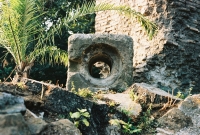 |
Stone pipe. This is the female end of the stone pipe. It appears to have been cut for a drain cover |
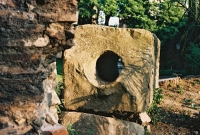 |
Stone pipe. This is the male end of the same stone pipe. |
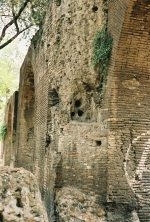 |
Clay pipes. This plate shows three clay pipes tapped into Aqua Claudia. These sets of arches are located near the Porta Maggiore. |
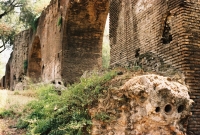 |
Clay pipes. This is a longer view of the same spot. Lower right corner shows the three clay pipes emerging from the concrete. |
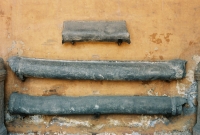 |
Lead pipes. The two longer pipes in this plate are about twelve feet long. |
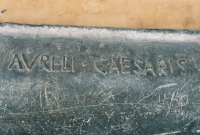 |
Lead pipes. This is a close up of the middle pipe. This inscription dates the pipe to the reign of Marcus Aurelius. |
- Covered trenches
Some 80% of all Roman aqueducts were laid subterranean. The easiest way
was to dig a trench, to build or cut the channel or laid the pipes and
to cover it up. Example:
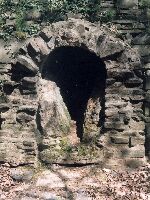
- Substructions
Sometimes extra walls were built to get the right level for the
conduit. This was only done for a height less that 2 meter. Example:
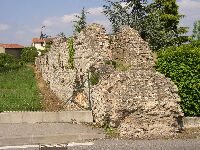
- Arcades
To get the aqueduct on a higher position than 2 meters, a series of
arches was built. The best know examples are found in the area of Rome.
Example:
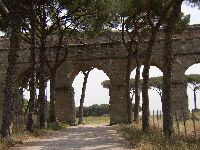
- Bridges
To 'bridge' a gap in the terrain and to prevent a long detour,
especially to cross a valley or a river, a bridge for the aqueduct
conduit was built. The highest bridge almost 50 meters above the river
Gardon is the famous Pont du Gard, part of the aqueduct op Nîmes
(France), but there are many more examples. In the case of the Metz
aqueduct (France) a double channel crossed the Mosel river on one
bridge, to facilitate maintenance (??)
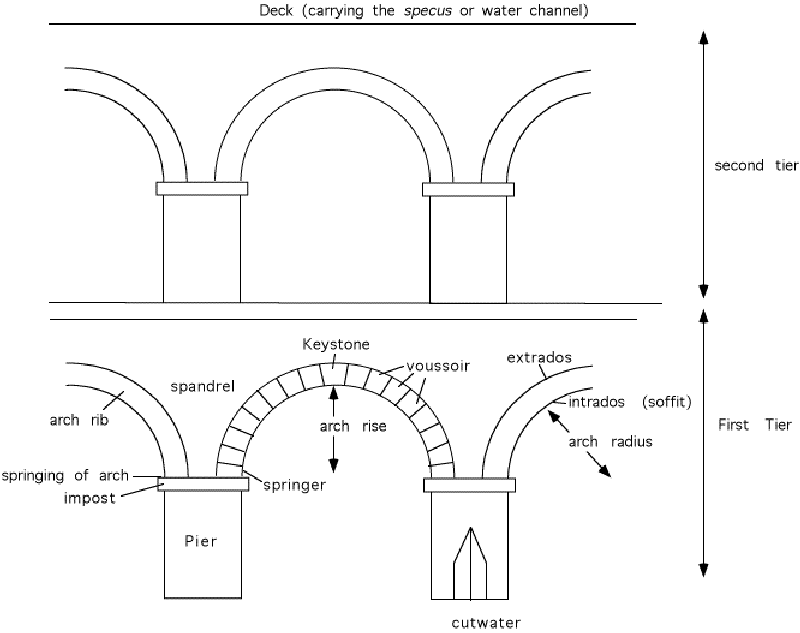
©2004 C.W. Passchier
Terms in other
languages
- Tunnels
To prevent detours a tunnel could be necessary. For a number of reasons
(to prevent lining problems - there are odd examples of
miscalculations in aqueduct tunnels - to save time and to make more
economic use of the labour force etc) the Romans often used the qanat
way of tunnel construction inwhich multiple vertical shafts were dug
over a hill top after which the bottom of the shafts were connected with eachother.
The longest Roman tunnel, as far as we know, is the Mornant tunnel in
the Gier aqueduct of Lyon (France): 825 meter long. There may have
been a 2250 meter long aqueduct tunnel in the Anio Novus aqueduct of
Rome.
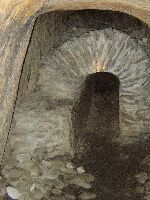
- Manholes
Manholes were vertical inspection shafts which were spaced nearly always at regular
intervals, one or two actus (35,5 or 71 meter) apart. They were built up to 0,7 m above ground level.
Their main purpose was for cleaning and repairs and/or to air the water.
Sometimes the building shafts of qanat-built tunnels (see above)
also acted as inspection manholes after the construction work was done.
Different types of manholes
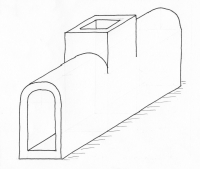 |
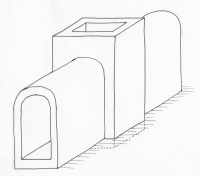 |
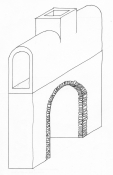 |
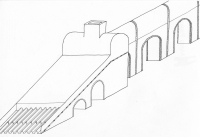 |
| Manhole with a small base |
Manhole with a broad base and settling basin |
Manhole on an arcaded aqueduct |
Manhole on a siphon basin |
©2004 W.D. Schram
Types in other languages
There are many ways to get (ground)water into an aqueduct. The most
common ones are:
1. Spring boxes and Well intakes
seem te be the active and passive means to collect water in a
rectangular chamber; the water was supplied through numerous splits or
specially created, sometimes arched, openings. A single outlet
discharges the water into the aqueduct conduit. |
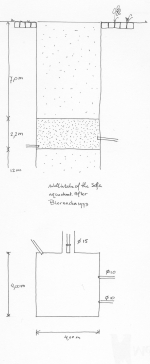 |
 |
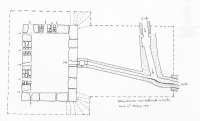 |
| More drawings |
A well intake, start of the Sofia aqueduct (Bulgaria) |
Springbox at Noé, one of the branches of the aqueduct in Sens (France) |
The Klausbrunnen near Kallmuth, part of the Cologne aqueduct (Germany) |
2. Infiltration galleries
Infiltration galleries were sections of aqueduct gallery, 20 - 100 m long which
ran along a hill side to intercept the flow of water that trickled out of the splits in the wall
into the gallery. At one side the water was collected into a settling
basin to get rid of the debris and sediments: the start of the aqueduct. |
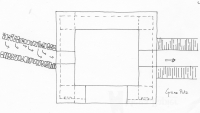 |
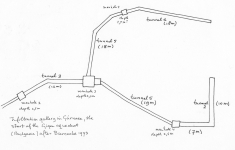 |
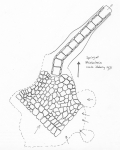 |
| More drawings |
Infiltration gallery and settling basin at
Grüne Pütz, start of the Cologne aqueduct (Germany) |
Different types of infiltration areas in one
system, Gigen (Bulgaria) |
Infiltration area near Miesenheim (Germany) |
3. River intakes
A river as a source for an aqueduct was not very popular in Roman times |
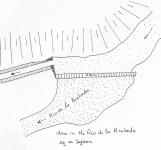 |
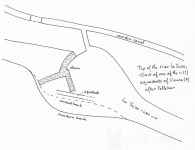 |
|
| More drawings |
This river intake of the aqueduct op Segovia (Spain) is still in use |
Impression of the river intake of one of the many aqueducts of Vienne (France) |
|
4. Dams
Springs were the commonest source for roman aqueducts. River intakes
were used occasionally. Artificial created lakes as a source were rare
although they could have been used to equilize the variations in the
seasonal flow rates of the feeding spring(s) |
 |
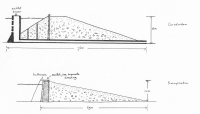 |
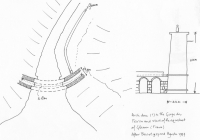 |
| More drawings |
General view on a Roman dam with spillover |
Two aqueducts of Merida (Spain) were fed by water from artificial Roman dams |
Hypothetical arrangement in the Gorge de Peirou, water for Glanum (France) |
1. Levelling
| Given the elementary means, materials
en tools which were available, it is remarkeble to see the precision
withwhich the Roman aqueducts were laid out. The mean gradient of a
Roman aqueduct was something between 0,15 - 0,30 %. As far as we know the
most applied leveling instruments were the chorobates and the groma. |
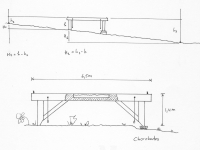 |
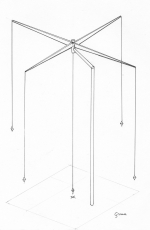 |
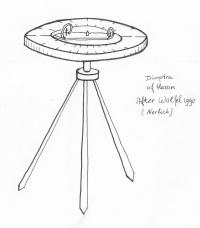 |
| Chorobates |
Groma |
Dioptra of Heron |
2. Channel (cross section)
Terms in
other languages
1 = trench
2 = foundation
3 = footing
4 = floor
5 = vault
6 = extrados
7 = intrados, soffit
8 = imprint of the formwork
9 = side wall
10= plaster
11= coating
12= quateround
13= concretion
14= aqueduct water
© 2004 W.D. Schram |
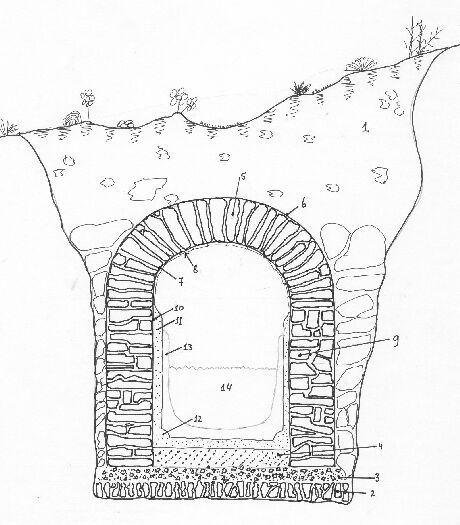 |
3. Roofs
Different types of roofs of an aqueduct
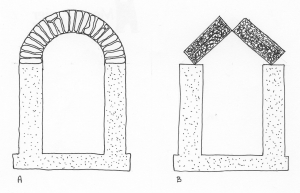 |
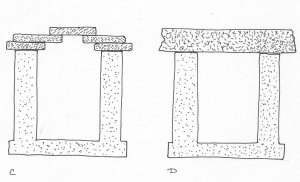 |
| GB: vaulted roof |
GB: gabled roof |
GB: corbelled roof |
GB: flat roof |
©2004 W.D. Schram
Terms in other languages
4. Materials
Water was transported in an open channel or in specific cases in a
pipe. The most applied materials were masonry, pipes of terracotta /
earthenware, wood (to be traced by metal rings) and lead (as used in
siphons and inside the towns)
5. Roman concrete: see
Opus caementicium
- Siphons
Where a valley to be crossed was too deep or too big for a bridge, a
siphon was built. The aqueduct water ran into a distribution tank,
often called header basin. A row of parallel (lead) pipes (e.g. 9) left
the other side of the tank and descended into the valley,
crossed the bottom on a so called 'venter' bridge and climbed up to the other side
to the 'receiving' basin from which the water continued in a masonry channel
to its destination.
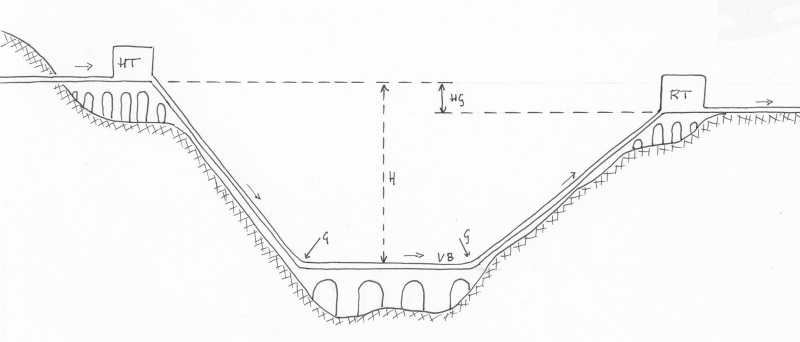
© 2004 W.D. Schram
Terms in other
languages
HT = Header Tank
H = Height
VB = Venter Bridge
HG = Hydraulic Gradient
RT = Receiving Tank
G = Geniculus (bend)
- Steep chutes
What is generally called a 'Waterfall' is a term used for different
types of installations, which have one item in common: how to get rid
of the energy stored in the waterstream.
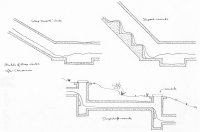 |
| Some examples,
derived from sites all over the Roman world, as researched by prof.
Chanson (Australia) |
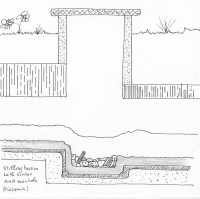 |
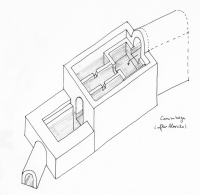 |
| Stilling basin at the interchange
between two parts of an (hypothetical) aqueduct as can be find at
Lessenich in the Cologne aqueduct (Germany) |
System of basins at the end of
the Conimbriga aqueduct (Portugal) |
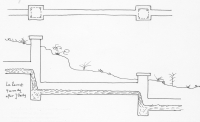 |
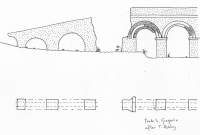 |
| A series of dropshafts near Le
Recret in the Yzeron aqueduct of Lyon (France) |
A 'waterfall' in the Mola di San
Gregorio valley in one of Rome's aqueducts, the Aqua Anio Vetus (Italy) |
- Crossings
A crossing of two of more aqueducts is very exceptional but it exists:
| The water supply of the town of Costantinopel was very
complicated: in every era there were repairs, alterations and
innovations. Near the Antonine wall two aqueduct lines met and crossed
the Kuršunlugame valley, but they also crossed each other. |
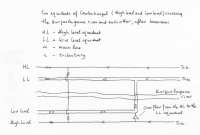 |
|
The great aqueduct crossing: Tor Fiscale just outside
Rome (Italy) including a 13th century watchtower. From left the
combined channels of the Anio Novus and the Aqua Cluadia; from right
the channels of the Aquae Marcia, Tepula and Claudia.
Painting: Zeno Diemer, Deutsches Museum München (Germany).
Drawing form Ashby1934, pag 137. |
 |
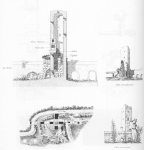 |
| Although they are not aqueducts, the Side arrangement is worth to
look at in detail: one creek entered another with such a force that its water crossed
over the other side where it was captured by the Side aqueduct (Turkey) |
 |
|
|
